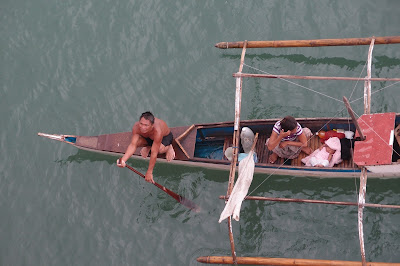(In 1978, the Edward Saïd published a book called Orientalism. In it, he describes orientalism as the subtle and pervasive prejudices against people of the Middle East. These prejudices romanticise (and caricaturise and even daemonise aspects of) Arabic culture, and are used to justify the colonial and imperial goals of Europe and the USA. The current US 'war on terror' is one example of how (neo) orientalism has real-life consequences today.)
Technically, from a geographical standpoint, harbouring 'subtle romantic yet harmful prejudices' about the Filipinos and Filipino culture cannot be orientalist because the Philippines is in Southeast Asia and not the Middle East. But, creating or reinforcing simplistic stereotypes can be just as detrimental.
So, with these caveats, here are some images snapped from aboard a ferry in Cebu City.
In the hour between boarding and departure from the port an economic (and cultural) exchange takes place.
 Over the ferry intercom, an authoritative voice reminds passengers that they should not throw money at the people in the bangkas. Such actions can cause injury. The warning falls on deaf ears. Rather than dissuading passengers from engaging in such activity, the announcement seemingly has the opposite effect. A large crowd appears on the starboard deck. The passengers empty the coins from their pockets and slip rolled bills into empty plastic drink containers. They scan the water below.
Over the ferry intercom, an authoritative voice reminds passengers that they should not throw money at the people in the bangkas. Such actions can cause injury. The warning falls on deaf ears. Rather than dissuading passengers from engaging in such activity, the announcement seemingly has the opposite effect. A large crowd appears on the starboard deck. The passengers empty the coins from their pockets and slip rolled bills into empty plastic drink containers. They scan the water below.Ten bangkas putter up alongside the ferry, each carrying two to six people. They wear little and very lightweight clothing. No bathing suits. Most of the boats have both children (including infants) and adults. One young woman pauses during the exchange to nurse her baby.
When a passenger tosses a coin or bill from the ferry, there's a flurry of activity. Often, the passenger makes a show of preparing to throw down money. One, two or three of the bangkas glide through the water nearing the passenger. The people below try to make eye contact with the passenger and unfurl their catching tool. The coin is tossed. If it lands in the catching tool, the catcher tilts the tool so the coin slides into the boat. If the coin misses, then one or several people will dive into the water to retrieve it. The water retrieval success rate is surprisingly (to me) high.
The exchange lasts thirty minutes. The ferry horn blasts. The passengers head back into their cabins, the cafeteria or the karaoke bar. The bangkas depart; some propelled by human paddling, others by motor.
What is your response to the images. Is it pity or guilt? Amazement or incredulity? Or nothing at all? What stories do the images tell? Tales of poverty and desperation? Or tales of creativity and ingenuity? Or something else entirely?




No comments:
Post a Comment